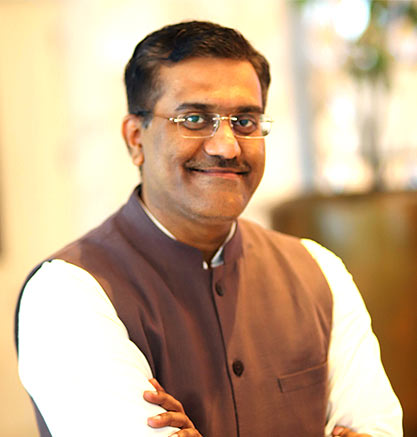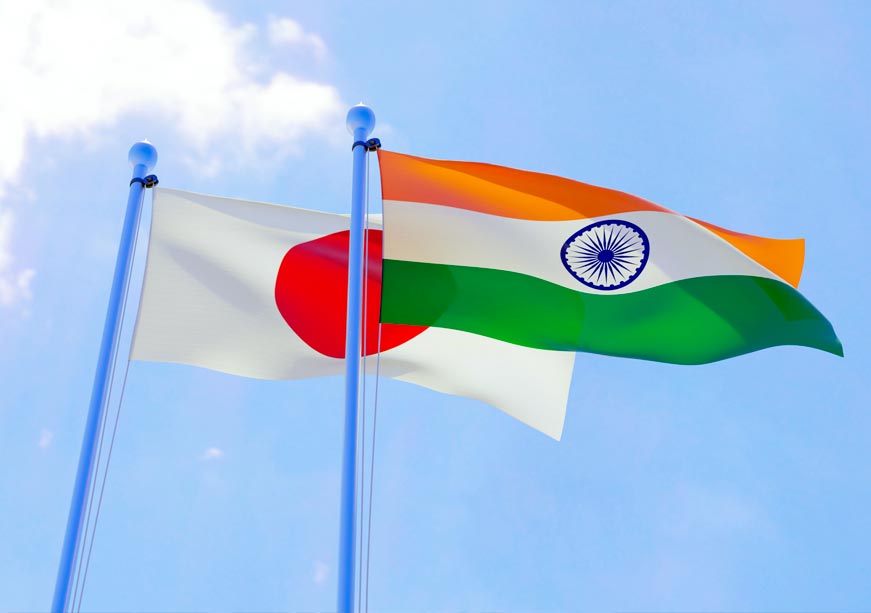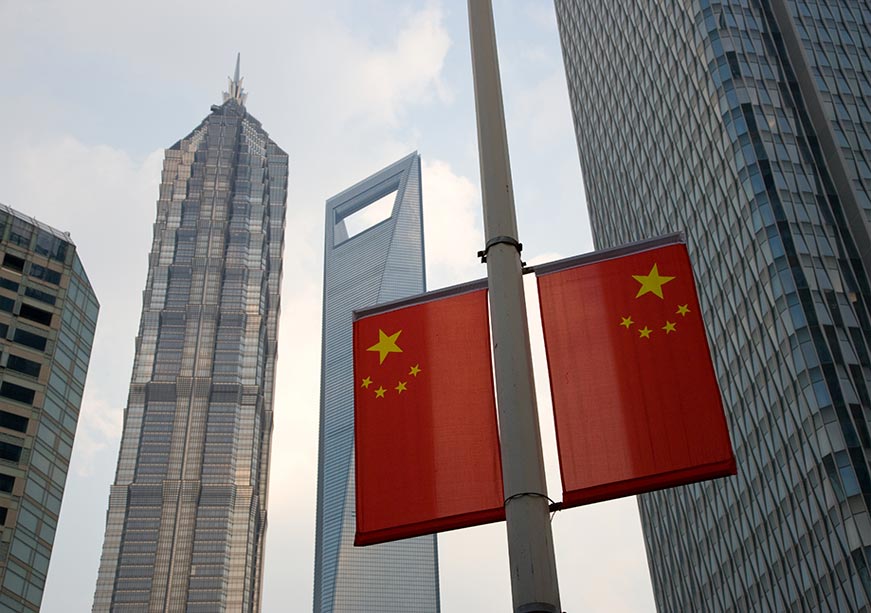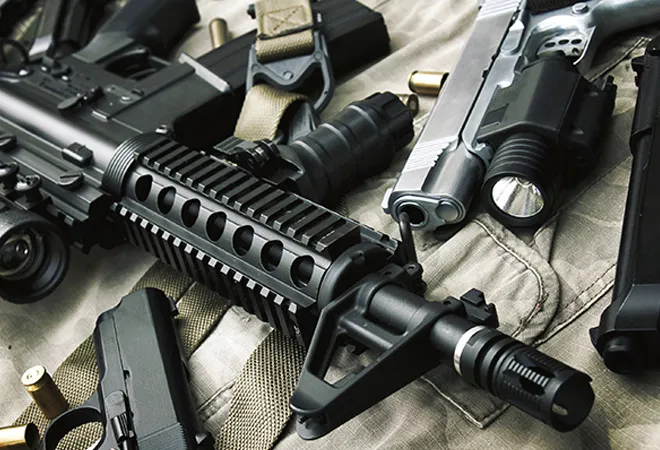
During the ongoing Ukraine crisis, a lot of the debate surrounding India’s ‘neutral’ stance on the Russian invasion of Ukraine has focused on India’s dependence on arms imports from Russia. This piece explains India’s arms imports from Russia and what it means for India’s defence industrial capacity and India’s foreign policy.
Legacy of the Cold War
India began to import weapons from Russia in the 1950s. The Ilyushin Il-14 cargo transport aircrafts were the first ones to be inducted into the Indian inventory, followed by the MiG-21 fighter aircraft. From 1962 onwards, there has been a steady increase in India’s import dependence on Russia. The legacy still leaves India with a sizeable number of Soviet-built platforms and in the post-Cold War period, India has made several sizeable acquisitions.
Table 1 explains the types of weapons imported from Russia between 1999 and 2021. We begin with 1999, because not too many significant acquisitions were made during the period 1987-1998, barring a very limited number, which is often considered the “lost decade” in India’s defence procurement history. As the pattern and nature of India’s acquisitions reveal, Russia still holds an apex position in the Indian defence market. Table 1 reveals the diversity of weaponry that India has sourced from Russia over more than two decades and the extent of its dependence on Russian imports. If not all, but much of this equipment will remain operationally active in the Indian inventory for at least the next two decades.
Table 1: Types of weapons imported from Russia (1999-2021)
| Types of weapons |
Weapons/Equipment |
| Missile systems including missiles and missile launcher and artillery systems |
1999-2005: R-27ERI-40 R-27ETI-36 R-73E-100 RVV-AE 30, Uran 3M 24 E, Uran 3M 24E combat missile, Uran 3M 24E NH practice missile, Klub missile, combat, Klub missile, practice, Containers for Klub missile, Launchers for RVV AE missile, Club Anti-Ship Missile Launcher
2006-2011: Air to Air missiles, SAM (3M 24E), Missile system of large calibre 9A52-2t Launching system Smerch MLRS, Transponder Loader Vehicle, 9A52-2T MLRS “Smerch”, 9T234-2T Transport Loading vehicles, SAM (9M38M1), SSM (3M54E), Land attack missiles (3M14E), Missiles R-73E, Anti-ship missiles
2012-2016: Anti-aircraft guided missiles for Strella 10M (Army), RVV — AE missile, Konkurs Missiles, Invar Missiles, Smerch Rocket Projectiles, 122 mm Rocket projectiles, GRAD (BM)
2017-: S-400 Triumf missile defence systems, 9M114 Kokon Anti-Tank Guided Missiles, Smerch rocket launcher systems, 3M-54E Klub cruise missiles, R-27R, R-73 and R-77 air to air missiles
|
| Aircraft and helicopters |
1999-2005: SU-30 ac, Aircraft SU-30 MK1, MIG-21 UM, Kamov-31, MI-17 IV, IL-38
2006-2011: CSU 30MK1, Su-30MK1, MiG 29K Ship-based fighter aircraft (Navy), MI-17 V5 Medium lift helicopters (Air Force), KA-31 Ship-based helicopter (Navy)
2012-2016: MiG 29K Ship-based fighter aircraft (Navy), MI-17 V5 Medium Lift Helicopter (Air Force), KA31 Ship-based helicopter (Air Force)
2017: MiG-29K naval fighter aircraft, Su-30MKI fighter aircraft kits, Ka-31 naval helicopters
|
| Ships, submarines and naval systems |
1999-2005: Kilo Class Submarine, Krivak class guided missile frigates
2012-2016: Follow on ships 1135.6 (Navy), INS Vikramaditya (nee Gorshkov) Aircraft Carrier
2017-: INS Chakra nuclear submarine (on lease)
|
| Battle Tanks |
1999-2005: Battle tanks (T-905/T-905K)
2006-2011: T - 90C, T - 90CK, T-90, S & SK tanks
|
Source: United Nations Register of Conventional Arms, SIPRI Arms Transfer database
Post-Cold War era trends
India’s imports from Russia over the last 30 years as shown in Chart 1 reveal that the decade between 1991 and 2001 was the leanest for Russian arms transfers to India. Two main factors explain the limited imports by India from Russia. Firstly, the collapse of the erstwhile Soviet Union constrained supply and delivery from the Soviet Union’s successor—the Russian Federation. The second factor explaining the limited Indian imports from Russia was due to the smaller allocations made for capital acquisitions (which cover big-ticket items such as warships, fighter aircraft, etc.) as part of a succession of Indian defence budgets during the decade. Indeed, this period witnessed US$7.65 billion worth of arms transfers from Russia.
The next decade 2001-2010 witnessed a US$14 billion increase, almost twice as much as the preceding decade. In the decade between 2011 to 2021, Russia made US$22.8 billion worth of arms transfers to India, which was 42.5 percent higher than the previous decade. Even if we were to exclude the year 2021, the arms transfers made by Russia would still be 36.4 percent higher than in the period 2001–2010. This is instructive, whilst other suppliers have gained, as to be seen below, India’s dependence on Russian defence imports has only increased at least in terms of capital expenditure.
The next decade 2001-2010 witnessed a US$14 billion increase, almost twice as much as the preceding decade.
Chart 1: Russian arms transfer to India since 1991
 Source: SIPRI Arms Transfer Database, figures in millions of dollars
Source: SIPRI Arms Transfer Database, figures in millions of dollars
In the decade between 2011 and 2021, as shown in Chart 2, the Trend Indicator Value (TIV) of India’s imports from Russia was highest at US$22.8 billion. In the same period, India’s total imports from the United States, the United Kingdom, Israel, and France stood at US$13.5 billion or 59.21 percent of Russia’s total imports to India. Similarly, the import share of these four countries was approximately US$2.1 billion or roughly 16.8% more than half of Russia’s share in India’s, during the same period.
However, a closer glance at Chart 2 also indicates that India’s arms imports from the next two largest supplier states—France and the United States stood at US$4.6 billion each and together US$9.2 billion. Over the same period, France and the US’ combined import share to India was the US $2.2 billion or 21.3 percent constituting less than half of India’s total imports from Russia. Whilst this suggests that India’s arms dependence on Russia in absolute terms is still high, nevertheless, the TIV of India’s imports from non-Russian sources surged relative to Russia’s share in India’s import basket and compared favourably to the previous decade—2001–2011.
In the years between 2001 to 2011, India’s total arms imports from Russia stood at US$17.29 billion as shown in Chart 3. Russia’s imports to India were more than five times greater than the next four largest suppliers, as shown in Chart 3, whose total imports to India constituted US$3.32 billion. Thus, in this period the four largest non-Russian suppliers’ share of India’s imports stood at 19.20 percent of Russia’s total imports to India, contrasting sharply with the decade between 2011 and 2021 when the four largest non-Russian suppliers’ share of India’s imports stood at 59.21 percent of Russia’s total imports, which was little over three times higher than the previous decade. India’s gross imports from Russia were US$5 billion more in the decade between 2011 to 2021 than in the previous decade between 2001 to 2011. Nevertheless, the TIVs, at least in the last decade, reveal a surge in India’s imports from non-Russian sources, but Moscow is still in the lead as the single largest supplier albeit with a smaller margin.
Chart 2: TIV of India’s arms imports (2011-2021)
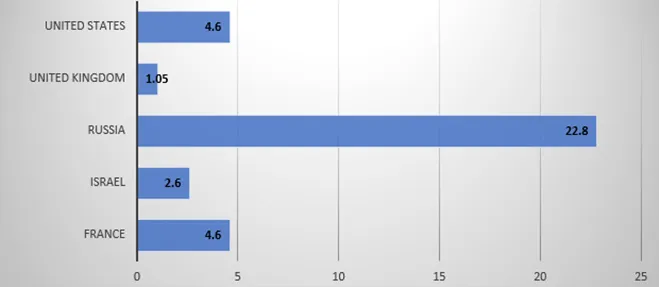 Source: SIPRI Arms Transfer Database
Source: SIPRI Arms Transfer Database
Chart 3: TIV of India's Arms Imports (2001-2011)
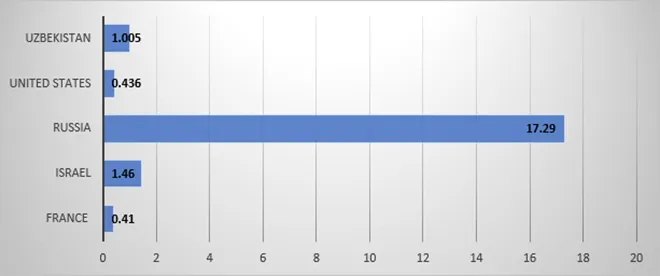 Source: SIPRI Arms Transfer Database
Source: SIPRI Arms Transfer Database
Finally, Russia’s share of India’s imports remains high relative as compared to the four other major suppliers to India. A glance at Chart 4 reveals that in 2021, France at US$2.1 billion, was the only other supplier exceeding Russia’s share in India’s arms imports. Otherwise, no other country during the period of 2011 to 2021 exceeded Russia’s import share. The United States managed only a distant second in the year 2014 supplying US$1.1 billion compared to Russia. Russia cumulatively managed to supply over US$1 billion. However, the other four non-Russian suppliers have made sizeable gains in India’s arms imports as seen in Chart 2.
Chart 4: Russia’s share in India’s arms imports as compared to other major suppliers (2011-2021)
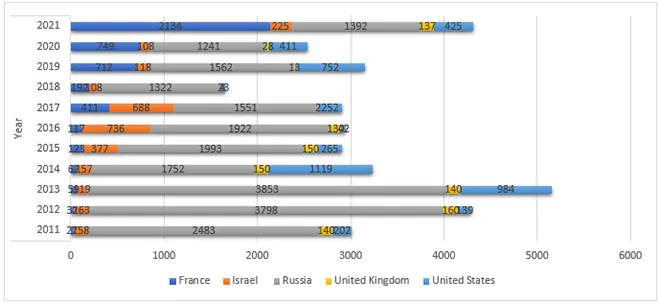 Source: SIPRI Arms Transfer Database, figures in millions of dollars
Source: SIPRI Arms Transfer Database, figures in millions of dollars
If the current TIV patterns persist over the next decade—2021–2031, and if India’s current defence industrialisation drive remains on track, the margin between Russia’s share and the other suppliers will shrink further.
The views expressed above belong to the author(s). ORF research and analyses now available on Telegram! Click here to access our curated content — blogs, longforms and interviews.








 PREV
PREV

